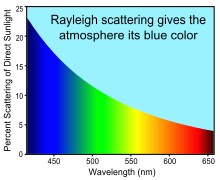What is Scattering of Light - Diagram, Types, Example, FAQs
When a beam of light interacts with a particle of matter, it is deflected in many different directions, which is known as scattering.
The most important aspect of everyone's existence is light. It exists in the form of photons, which are tiny packets of light.
The Scattering of light is discussed in this article. We'll also figure out why a clear sky appears blue and clouds are white and other scattering of light examples.
Scattering of light is a term used to describe how light is dispersed.
JEE Main/NEET 2027: Physics Important Formulas for Class 10
NEET 2025: Mock Test Series | Syllabus | High Scoring Topics | PYQs
JEE Main: Study Materials | High Scoring Topics | Preparation Guide
JEE Main: Syllabus | Sample Papers | Mock Tests | PYQs
- Diagram of Scattering of Light
- There are several types of scattering of light:
- Scattering of Electromagnetic Waves

Diagram of Scattering of Light
Also read -
- NCERT Solutions for Class 11 Physics
- NCERT Solutions for Class 12 Physics
- NCERT Solutions for All Subjects
One of the essential phenomena in our daily life is scattering of light. The blue colour of the sky and the colour of the rainbow, and so on, has been observed by everyone since childhood, possibly because of the Scattering of light. Scattering of light differs from light reflection and refraction in a significant way. The light beam is reflected in a straight path, but the light ray is scattered in diverse directions by the medium through which it passes in Scattering.
When a ray of light passes through a medium, it collides with the particles that are present. As a result, some photons are absorbed while others are spread in all directions.
When light strikes airborne particles, the particles refract the light.
Some light is absorbed, while the rest is radiated in all directions except the incident direction. This is referred to as "scattering of light." The strength of the Scattering is determined by the wavelength of the light and the size of the particle that scattered it. When the sun's rays penetrate the earth's atmosphere, they collide with the particles that are already present. Some of these photons are absorbed by the particles, while others are distributed widely.
There are various examples of scattering of light. However, the following are the two most common ones:
- Reflection caused by a rough surface
- Impurities in the volume cause reflection, refraction, or diffraction.
Reflection from a Rough Surface at Random:
The environment's surfaces are all rough. The amount of light dispersed is determined by the roughness of the surface and the wavelength. The rougher the surface, the more light is absorbed. Also, depending on the wavelength of the light, it will disperse in different directions. Random reflection from rough surfaces is best demonstrated by the roughness of cars and pieces of jewellery.
Volume Reflection in the Presence of Impurities:
The charged particles disperse the light in this area.
There are several types of scattering of light:
- Rayleigh scattering
- Mie scattering
- Electromagnetic Scattering
Rayleigh Scattering:
Rayleigh scattering is named after Lord Rayleigh, a 19th-century physicist. It is the elastic Scattering of light by particles of a size smaller than the incident light's wavelength. The sky seems blue because the red colour has a long wavelength and does not disperse. This event is followed by signal scattering via the optical fibre.

Mie Scattering:
Mie's solution to Maxwell's equation is this Scattering. The particle size is larger than the wavelength of the light in this form of Scattering. As a result, non-uniform dispersion occurs. It's also a sort of elastic Scattering.
Example-
The sky seems blue, and the clouds appear white due to this dispersion, as does the colour of the fog and water droplets.
Scattering of Electromagnetic Waves
Electromagnetic Scattering is a type of Scattering in which electromagnetic waves are continually deflected.
There are two types of it:
- Elastic Scattering
- Inelastic Scattering
Rayleigh and Mie scattering are examples of elastic Scattering, whereas Raman and Compton's Scattering are examples of inelastic Scattering.
The following are the factors that influence scattering of light:
- The size of the molecule or particle.
- The incident light's wavelength.
When the wavelength of incident light striking the earth's surface has a shorter wavelength and a higher frequency, like in the case of blue, it scatters more. The incident light is deflected less if it has a long wavelength and a low frequency, as in the case of red.
Related Topics Link, |
The wavelength of light and the probability of Scattering of light have a relationship.
p∝14
Where p denotes the probability of scattering of light.
= the light's wavelength
The chance of scattered light is larger for light with a shorter wavelength, as shown by the preceding equation.
because the likelihood is inversely related to the wavelength's fourth power
Scattering of light in Practice:
- The light scattered by the molecules/particles in the atmosphere causes the sky to seem blue.
- The sky appears crimson during sunset and sunrise due to Scattering of light.
- In terms of projectors.
Also Read:
- NCERT solutions for Class 12 Physics Chapter 9 Ray Optics and Optical Instruments
- NCERT Exemplar Class 12 Physics Solutions Chapter 9 Ray Optics and Optical Instruments
- NCERT notes Class 12 Physics Chapter 9 Ray Optics and Optical Instruments
What causes the Clear Sky to be blue? Why clouds appear white?


The clear sky is blue because, according to Rayleigh, Scattering of light, light scatters quicker as it falls on particles with a size smaller than the wavelength of light. Because blue has a shorter wavelength and a higher frequency than other colours, it oscillates at a faster rate. As a result, the clear sky seems blue.
Because of Mie scattering, the clouds are white. In the atmosphere, there are water droplets and big particles in the cloud.
As a result, when light with a shorter wavelength hits these big particles, nearly all of the colours divide evenly and scatter in all directions. White light is formed as a result of this. As a result, the clouds appear to be white.
NOTE: Rayleigh scattering only occurs when the particle size is smaller than the wavelength of the incident light, but Mie scattering occurs when the particle size is bigger.
Also check-
- NCERT Exemplar Class 11th Physics Solutions
- NCERT Exemplar Class 12th Physics Solutions
- NCERT Exemplar Solutions for All Subjects
NCERT Physics Notes:
Frequently Asked Questions (FAQs)
Scattering of light definition: Scattering of light occurs when light rays collide with an obstruction such as dust, gas molecules, or water vapours and divert from their straight course.
Scattering of light depends mainly on two factors:
Size of the particle/molecule.
Wavelength of light.
Clouds appear white due to Mie Scattering. In this case, the size of particles i.e. water droplets are larger than wavelength of light. Hence all the colours gets scattered equally which makes the clouds appear white.
Rayleigh scattering law: An object's scattering in all directions is inversely proportional to the fourth power of the illumination wavelength.
p∝14
There are two types of scattering
Elastic scattering
Inelastic scattering
Also Read
02 Jul'25 07:56 PM
02 Jul'25 06:11 PM
02 Jul'25 05:17 PM
02 Jul'25 05:09 PM
02 Jul'25 05:08 PM
02 Jul'25 05:08 PM
02 Jul'25 05:07 PM
02 Jul'25 05:07 PM
02 Jul'25 05:04 PM
02 Jul'25 05:01 PM


